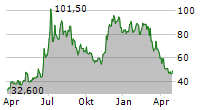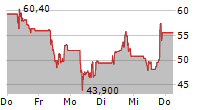PILA PHARMA AB (publ) (FN STO: PILA), an innovative biotech company developing novel oral drugs for treatment of obesity and diabetes based on TRPV1 inhibition, informs investors and others with interest in the space, that it has signed a contract with Danish preclinical Contract Research Organisation, Gubra.
The aim is to demonstrate preclinical proof-of-concept of PILA PHARMA's proprietary clinical drug candidate XEN-D0501 in rats with obesity.
During July, PILA PHARMA completed a rights issue of units to make "a bet on obesity" by demonstrating proof-of-concept on bodyweight regulation / obesity in first rats and then in humans.
The net proceeds of the unit rights issue, in July, provided the Company with finances to conduct preclinical trials of the Company's clinical drug candidate XEN-D0501 in obesity.
The associated warrants of series TO2 will have it's subscription period between 5 and 15 February 2026 after the read-out of the rat studies. The net proceeds from the warrants are intended to finance clinical trials of the Company's clinical drug candidate XEN-D0501 in obesity.
The new collaboration with Gubra will facilitate the first step to demonstrate proof-of-concept in obese rats.
The discussions on choice of obesity model and study design were initiated already in July when a "slot" in Gubra's research facility was also reserved. With all details now settled, the contract is signed.
It has been chosen to study the effect of 4 weeks of treatment with PILA PHARMA's TRPV1-inhibitor drug candidate XEN-D0501 in both obese male DIO and Zucker rats. The DIO rat is a standard obesity model where normal rats are fed a high fat diet to induce obesity. The Zucker rat is another relevant obesity model where rats due to a mutation spontaneously overeat and develop obesity on a normal diet, simply due to the excess amount of calories consumed.
Founder & CSO Dorte X. Gram comments:
"We're very pleased, to now be able to announce the selection of Gubra as our new contract research partner as they came highly recommended by big pharma due to their level of quality. It's been a great pleasure to discuss the details of choosing the relevant models for this first test of XEN-D0501's potential anti-obesity effect.
Generating proof-of-concept in obese rats would put PILA PHARMA in a unique position as a pioneering innovator in the space and enable further clinical studies in humans living with obesity with the goal of establishing a comprehensive and meaningful data package.
CEO Gustav H. Gram comments:
We're delighted to now announce this partnership that will enable us progress to see through our "bet on obesity". As of today, we still expect results before the warrant strike period (05-15 February 2026) and we will communicate more information, detailed timelines and guidance later in the autumn when the study starts."
For more information:
CEO, Gustav H. Gram
Email: ghg@pilapharma.com
This information is such information that PILA PHARMA AB is obliged to publish in accordance with the EU Market Abuse Regulation. The information was submitted for publication on 30 September 2025 at 17:15 CEST.
Pila Pharma's share ticker PILA is subject to trade on Nasdaq First North Growth Market, Sweden with Aqurat Fondkommission AB as Certified Adviser. Contact: M: ca@aqurat.se - T: +46 (0)8 684 05 800
About PILA PHARMA AB (Publ)
PILA PHARMA is a Swedish biotech company based in Malmö, Sweden. The aim of the company is to develop TRPV1 inhibitors as a novel treatment of obesity, type 2 diabetes and potentially of other diseases with an inflammatory background. The Company owns a TRPV1 asset with data and chemical entities including the development candidate XEN-D0501. Further, the Company owns use-patents covering the use of TRPV1-antagonists for treatment of obesity and diabetes and intends to submit further patents regarding the synthesis, formulation, or use of XEN-D0501 or back-up compounds. In July 2022, the Company was awarded orphan drug designation ("Orphan drug designation") for XEN-D0501 as a treatment for a painful rare disease Erythromelalgia. PILA PHARMA currently focuses on Obesity & Type-2 Diabetes whilst focusing on licensing opportunities for Erythromelalgia and Abdominal Aorta Aneurysm.
About XEN-D0501 and TRPV1 antagonists
XEN-D0501 is a selective, synthetic potent small molecule TRPV1 inhibitor that was in-licensed in 2016. The drug candidate is a small molecule currently formulated in a simple and stable tablet formulation.
TRPV1 inhibitors that down-regulate neurogenic inflammation, has demonstrated applications across pain and inflammatory diseases and potentially plays a role in diabetes and potentially other metabolic disorders like obesity. PILA PHARMA's founder and current CSO Dorte X. Gram, is the inventor of the principle of treating diabetes and obesity with TRPV1 inhibitors - a discovery-by-surprise during her PhD studies at Novo Nordisk, Denmark. Here she discovered that TRPV1 inhibitors would prevent glucose intolerance and body weight gain in spontaneously obese pre-diabetic rats. These results pointed to a new and previously undiscovered role of TRPV1 in regulating both blood glucose and body weight. Prior to in-licensing, XEN-D0501 had been found to have a good safety profile in other (non-diabetic) patient groups.
PILA PHARMA has to date completed two phase 2a clinical trials (PP-CT01 and PP-CT02), that both demonstrated that XEN-D0501 is well tolerated by in people living with obesity and type 2 diabetes. Further, in PP-CT02, it was demonstrated that XEN-D0501 (administered as 4 mg bi-daily for 28 days) - with statistical significance versus placebo - enhanced the endogenous insulin response to oral glucose. ANP, a cardiovascular biomarker for heart failure, was also highly statistically significantly reduced.
During 2023 the Company could report very good tolerability of XEN-D0501 following 13 weeks administration of very high doses in 2 animal species, and XEN-D0501 can thus progress into longer clinical trials. Currently, a new clinical phase 2a trial, PP-CT03, is being prepared. The objective of the study is to identify the maximal tolerable dose of XEN-D0501 in people living with obesity and type 2 diabetes and to evaluate the safety profile following 3 months chronic treatment. In addition to the safety assessment, PP-CT03 will also include sufficient participants that should allow for efficacy readouts on reduction of body weight. The Company is now, from autumn 2025, also preparing to assess the drug candidate in preclinical obesity studies. This could enable the company to have two tracks assessing the drug candidate in individuals living with overweight as well as with and without type-2 diabetes. The ambition is to create a comprehensive and meaningful data package that supports XEN-D0501 as an oral, potential first-in-class drug candidate.
About Obesity and Diabetes
Obesity (BMI >30) is pandemic in its essence with estimates of more than 1 billion people living with it in 2025. Overweight (BMI >27) is also at staggeringly high levels with estimates of 4 billion people globally.
It is most often preceding the development of type 2 diabetes and is a serious risk-factor for not only developing type 2 diabetes but also co-morbidities resulting in "whole body dysfunction" and subsequent development of several diseases. The accumulated effect is a year-long reduction in quality of life for obese people with or without diabetes. Obesity leads to an increased risk of developing cardiovascular disease that eventually results in premature death and shortening of life duration. Recent advances and the development of effective anti-obesity drugs, has proven that pharmacological weight management is possible and leads to obvious quality-of-life and longevity benefits for people living with obesity. Even long-term, public health costs are expected to be reduced if the clinically negative effects of the obesity pandemic are limited. This has sparked a general interest in future potential oral treatments that can meet the accessibility criteria needed to stimulate enormous and growing demand.
Diabetes is a similar spanning pandemic with strong ties to obesity, and with a staggering estimated prevalence of more than 828 million people living with diabetes corresponding to approximately 8-10% of the global adult population. Among these, its estimated that more than approximately 90 % of all diabetics suffer from type-2 diabetes, whilst approximately less than 10% suffers from type-1 diabetes. Despite recent therapeutic advances, large and growing unmet needs exist both from efficacy, safety, and accessibility standpoints.
Having previously completed two clinical trials in people living with overweight and diabetes, the Company is now, from autumn 2025, preparing to assess the drug candidate in preclinical obesity studies.
This could enable the company to have two tracks assessing the drug candidate in individuals living with overweight as well as with and without type-2 diabetes. The ambition is to create a comprehensive and meaningful data package that supports XEN-D0501 as an oral, potential first-in-class drug candidate.
About Erythromelalgia
Erythromelalgia is a rare disease where neurogenic inflammation plays a role in the development of symptoms. The disease can cause near-constant or episodic pain (ranging from mild tingling to severe burning sensations), and redness to extremities. It most commonly affects the feet but may also occur in the hands, face, or other parts of the body with both nerves and blood vessels involved. Symptoms are frequently managed through avoidance of pain triggers. The disorder can be extremely debilitating, with a significant negative impact on quality of life and with potential to impact mortality rates among young people and the suicide rates among adults. There are no current treatments available to patients, but it is widely believed by doctors that an oral solution with systemic effects would be highly preferable.
PILA PHARMA has made a draft clinical development plan for this project, and it is available both continuous studies as well as for out-licensing.
About Abdominal Aorta Aneurysm
Abdominal aorta aneurysm is a cardiovascular disease with 'ballooning' of the lower part of the main artery of the body, aorta. The cause is unknown, but risk factors are atherosclerosis, high blood pressure, cardiovascular inflammation and infection as well as trauma. It affects millions of people globally and accounts for the death of 1% of men over the age of 65. It develops gradually over several years up to a dilatation of more than 3mm in diameter when surgery to insert a stent to prevent rupture is then the only treatment option, which is both expensive and with possibility for complications. Currently no preventive treatment is available. In December 2024, in collaboration with Uppsala University, PILA PHARMA's TRPV1 inhibitor, XEN-D0501, was shown to significantly reduce abdominal aorta aneurysm growth in mice, establishing preclinical proof-of-concept and further establishing it potentially beneficial cardiovascular properties. The project should be able to progress to proof-of-concept clinical trials and is available for out-licensing for the right partner.
About Gubra
Gubra, founded in 2008 in Denmark, listed on Nasdaq Copenhagen, is specialized in pre-clinical contract research services and peptide-based drug discovery within metabolic and fibrotic diseases. Gubra's activities are focused on the early stages of drug development and are organised in two business areas - CRO Services and Discovery & Partnerships (D&P). The two business areas are highly synergistic and create a unique entity capable of generating a steady cash flow from the CRO business while at the same time enjoying biotechnology upside in the form of potential development milestone payments and potential royalties from the D&P business. Gubra has approx. 275 employees and in 2024 revenue of DKK 266 million.

